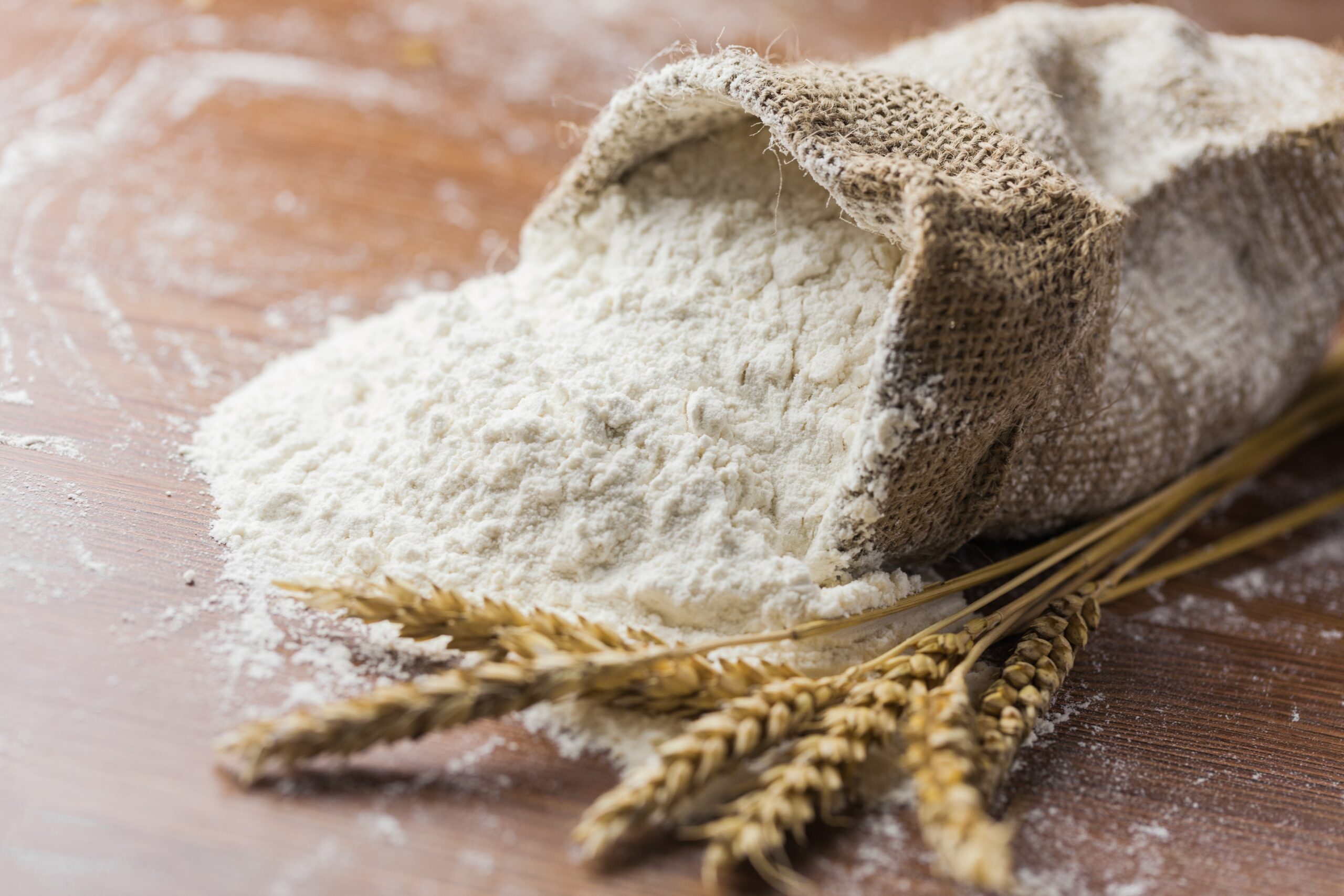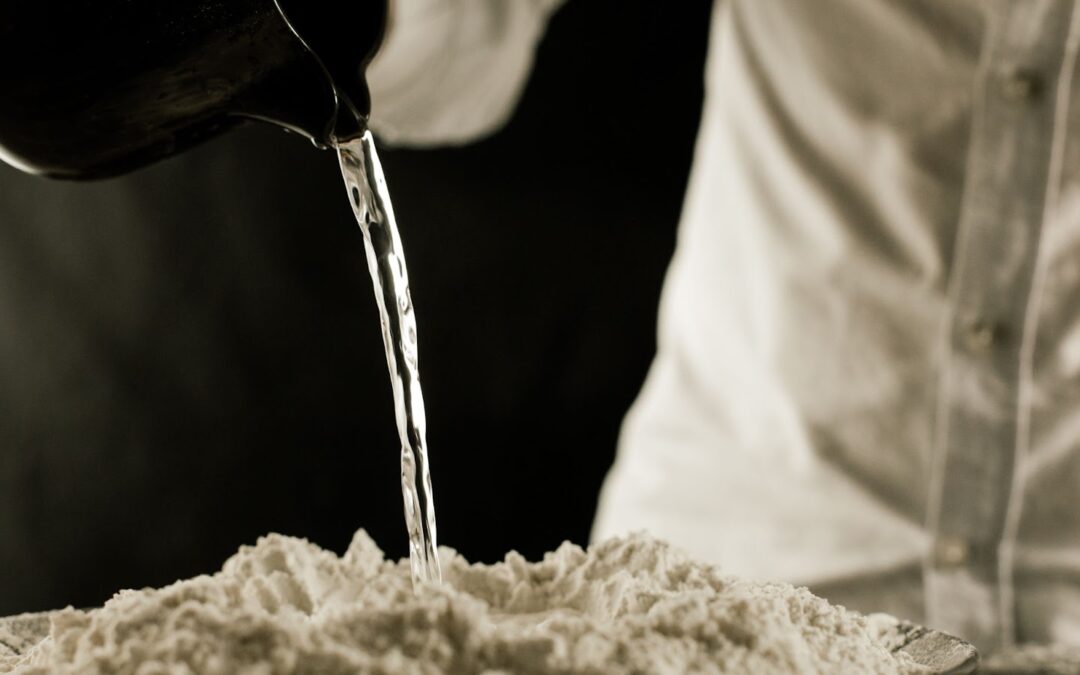The flour to water ratio is critical in many bread, pastries, and cookie recipes. To ensure your baked goods achieve the desired taste and texture and bakery yield, consider your flour’s ability to absorb water. Properly hydrating your flour reduces inconsistencies and improves finished product quality.
This article will provide context around water absorption in flour while explaining the consequences of baking with under- or over-hydrated dough. You’ll learn what factors influence water absorption in flour and what you can do to ensure you get your desired outcome.
Why is water absorption capacity important for flour?
Water absorption capacity of a flour impacts the consistency of the dough feel, the texture of the finished product and even unwanted mold development in bread. If your flour isn’t hydrated properly the challenges could be as simple as mixing and kneading to as complex as the ineffectiveness of the yeast. The amount of water directly impacts all stages of the baking process up to and including the dough yield.
Water absorption also plays a role in loaf volume and shelf life. Under- or over-hydrated dough can result in significant bakery issues even impacting the storage life of your finished products. An over-hydrated dough that contains excess free water, can be difficult to handle, may require more energy in baking or could even result in a higher likelihood of developing mold, whereas under-hydrated products limit yeast activity which adversely affects loaf volume and can result in a product that is dry too soon after baking.
An increase in water absorption can also increase a baker’s overall profitability. Using flour with a higher water absorption content increases the dough yield which allows you to stretch your resources further and increase production without incurring higher costs.
Over-hydrated vs. under-hydrated dough
Dough becomes problematic for bakers to manipulate if it’s under- or over-hydrated. The difference in a dough’s physical properties, its stickiness or stiffness are related to the proper amount of water.
Here are some signs and symptoms of over-hydrated dough:
● Difficult to mix or knead. Not only will you struggle to mix and divide the over-hydrated dough, but you can also run into quality issues when you try to adjust a formula on the fly by putting more flour into a wet mix.
● Feels silky. Properly hydrated dough is typically smooth and silky, but over-hydrated dough can feel excessively sticky.
● Rapid proofing. Over-hydrated dough may rise too quickly due to over active yeast.
● Sticky texture. Dough becomes challenging to handle when over-hydrated. It can stick to your hands, work tools, and other surfaces.
● Weak structure. Once the dough becomes over-hydrated, it won’t easily hold its shape. You may also notice that over-hydrated dough is more likely to break apart or produce flat bread during baking.
Under-hydrated dough is also a concern. If you notice any of the following issues, your bread dough might be under-hydrated:
● Cracking surface. As your dough bakes, you may notice excessive cracks appearing on the surface. Bread may also produce more crumbs than normal.
● Difficult to mix. Under-hydrated dough might be excessively stiff, and you’ll have to exert extra energy to mix the dough properly.
● Falls apart. If your dough isn’t staying together and crumbling apart, it could be under-hydrated.
● Poor rising. Like over-hydrated dough, under-hydrated dough doesn’t easily rise even after adding additional yeast.
● Slow proofing. Under-hydrated dough may struggle to rise in a normal amount of time.
To avoid these issues, take precautions when preparing the dough to prevent over- or under-hydrating your product. You’ll enhance the baked quality of your bread. and you won’t waste resources by throwing out dough that isn’t usable.

Different flours have different absorption rates
Some types of flour absorb more water than others.
High-gluten flour a higher protein content flour is often more absorbent because of gluten’s role in water retention. Medium protein bread flour usually holds, wheat in the 60-62% range and provides a good balance of water absorption capabilities and dough handling properties.
Whole-wheat flour tends to have the highest protein content (13% to 14%) among common types of flour, but much of that protein in non-functional. It does however hold a percentage of water due the increased fiber content of the bran and germ. However, because whole-wheat flour dough also contains the germ and bran the high fiber limits the ability of this flour to develop gluten during mixing.
Flour with a lower amount of protein doesn’t contain the same levels of gluten forming proteins which can limit water absorption. If the flour lacks gluten, it’s unable to hold the same amount of water by weight, and is often used for batter type products that do not include yeast or fermentation such as cakes or cookies.
Cake flour, often a short-patent flour, tends to have the lowest amount of protein of all wheat flours (usually less than 8%) and therefore a very low water absorbing flour, but prized for high ratio cakes. Pastry flour, typically a straight grade soft wheat flour has a slightly higher protein content than cake flour, but still doesn’t absorb as much water as a typical hard wheat. All-purpose flour often a blend of hard and soft wheat and varies in both protein and absorption capacity depending upon the blend ratios used.
Some other factors can affect water absorption, including:
● Bran content. Bran, the outer seven layers of a wheat seed has a high amount of pentosan, a component that can absorb up to 15 times its weight in water. You’ll find more bran in whole-wheat flour than in white flour, explaining (in part) why whole wheat flour is more water absorbent.
● Gluten forming protein content. Gluten forming proteins can absorb twice their weight in water, and flour with higher concentrations these proteins can absorb more water during the mixing process.
● Damaged starch. While undamaged starch absorbs less than half of its weight in water, damaged starch can absorb multiple times its weight in water. Some granules become damaged when wheat is ground into flour, and to more starch damage can increase the flour’s absorption potential.
How do you calculate water absorption in flour?
Use the following formula to calculate flour’s potential for water absorption:
Water weight / Flour weight expressed as a percentage.
This formula is known as water absorption capacity (WAC). The number is written as a percentage and demonstrates a correlation between the weight of flour and the amount of water used to hydrate.
Imagine you have 100 kilograms of flour with an expected water absorption rate of 60%. In this case, you should be able to add 60 kilograms of water to the flour to be formed into a dough.
Most flour has a water absorption rate between 55% and 62%. However, high-gluten flour can reach an absorption rate of close to 65-66%.
How protein and gluten affect flour water absorption
The available protein in flour contributes to the formation of gluten as water is mixed in. Flour with a higher protein and/or higher wet gluten measurement can absorb more water than a low protein flour or one with a lower wet gluten measurement. As flour is able to form more gluten when additional water is mixed in, the flour is said to have a higher absorption.
One way to increase the water absorption of a baking system is to add vital gluten to the mix. Vital wheat gluten is the extracted protein component found wheat flour. It usually contains between 75% and 80% protein and can be helpful when added in small amounts to a flour mixture.
Discover how VolMAX Flour Technologies can improve flour water absorption
As you can see, water absorption plays a critical role in developing high-quality dough and fresh-tasting baked goods. Using flour that can absorb more water during bread making can increase your economic output by creating more products with fewer materials.
You’ll stretch your budget further while improving your productivity and optimizing your production.
VolMAX Flour Technologies optimize your raw material to improve water absorption without sacrificing production quality. This is one of many products Engrain offers to help customers save money and increase products.
Contact Engrain for more information about how we can partner with your business.

Very informative
Thanks
What I understand is that whole wheat flour or flour with more bran content obsorbs more water that white flour but Gluten forming capability is less in whole wheat flour.
I think I am correct?
You are correct that whole wheat flour absorbs more water due to the bran. The gluten forming capability of the “white flour portion” of a whole wheat flour is unchanged, it is just a smaller percentage of the whole because of the added bran and therefore less effective in providing the structure needed to make a good loaf. Also, there is the thought that the bran particles act as knives to cut the gluten during mixing and fermentation. This also weakens the available gluten effectiveness.